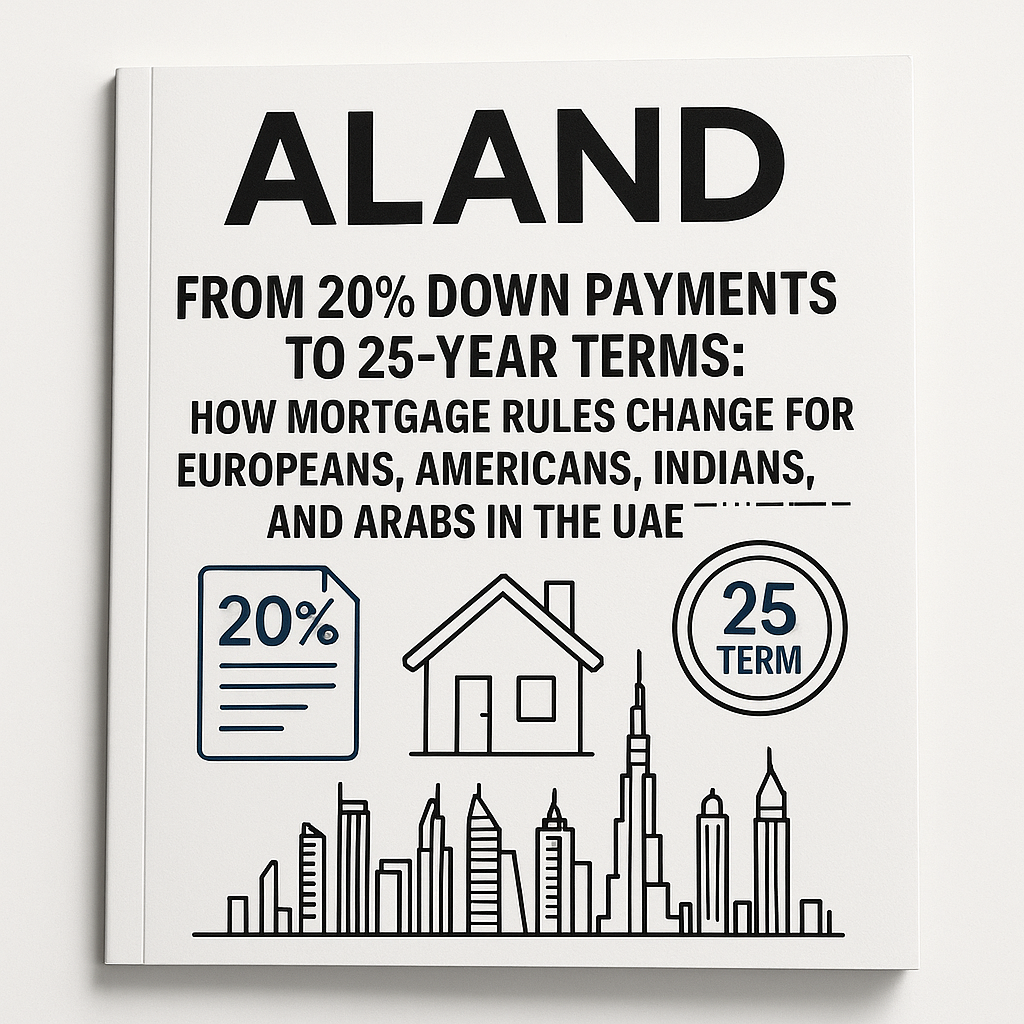From 20% Down Payments to 25-Year Terms: How Mortgage Rules Change for Europeans, Americans, Indians, Iranians, and Arabs in the UAE
- Published Date: 29th Sep, 2025
-
4.8★ ★ ★ ★ ★(129)

By Dr. Pooyan Ghamari – Swiss Economist, Founder of the ALand Platform
Dubai’s property market has matured into a global magnet for capital — no longer just a luxury playground but a serious investment hub. Yet one detail remains underexplored: mortgage rules are not uniform for everyone.
How much you can borrow, the down payment required, the interest you’ll pay, and the length of your loan all depend on nationality, residency, and visa status. These distinctions reflect risk models, regulatory frameworks, and financial agreements the UAE has built with different regions.
For global investors, understanding these nuances creates leverage. With the right knowledge, you can negotiate better terms, stretch your purchasing power, and strategically structure your portfolio.
This guide breaks down the UAE’s mortgage landscape for Europeans, Americans, Indians, Iranians, and Arab nationals — and how to use those differences to your advantage.
Why Nationality and Residency Still Matter
UAE banks are globally connected, but they remain risk-sensitive. When assessing borrowers, banks consider:
-
Home-country financial systems – strong regulations = lower risk
-
Currency stability – stable currencies = better mortgage terms
-
Data transparency – access to reliable credit and tax records improves LTV
-
Legal recourse – ability to enforce claims across borders impacts approvals
Residency adds another layer. UAE residents or Golden Visa holders are considered safer bets than non-residents, even with identical income. That perception directly impacts down payments, terms, and rates.
1. Europeans: The Preferred Borrowers
Why banks like them: Stable currencies, reliable documentation, and legal cooperation.
-
Down payment: 20%–25% (residents), 30%–40% (non-residents)
-
LTV: Up to 80% (residents), 60%–70% (non-residents)
-
Tenure: Up to 25 years
-
Rates: 4.5%–6.5%
Insight: Opening UAE accounts and routing rental income locally often unlocks better terms. Golden Visa residency improves LTV and rates further.
Case: A German non-resident buying AED 2.5m property secures a 65% mortgage (AED 1.625m). Upon residency, they could access 80% financing and lower their rate.
2. Americans: Strong But Scrutinized
Why banks hesitate: FATCA compliance increases documentation burdens.
-
Down payment: 20%–25% (residents), 30%–40% (non-residents)
-
LTV: Up to 80% (residents), 60%–70% (non-residents)
-
Tenure: Up to 25 years
-
Rates: 4.8%–6.2%
Insight: Offshore company structures or dual banking setups can ease compliance. Specialist FATCA-compliant products are also emerging.
Case: A U.S. buyer of a AED 3m villa secures a 70% loan, though approvals take longer due to IRS reporting checks.
3. Indians: High Volume, Shorter Terms
Why banks adjust terms: INR volatility and less predictable credit records.
-
Down payment: 25%–30% (residents), 35%–40% (non-residents)
-
LTV: Up to 75% (residents), 60%–65% (non-residents)
-
Tenure: 20–22 years
-
Rates: 5.2%–6.8%
Insight: Income in USD/GBP reduces risk premiums. Golden Visa status improves LTV and terms. Developer post-handover plans are especially popular among Indian buyers.
Case: An Indian investor secures a 65% mortgage (~AED 1.17m) on a AED 1.8m unit. Yields outpace interest, ensuring positive cash flow.
4. Iranians: The Most Restricted
Why banks limit: International sanctions and compliance barriers.
-
Down payment: 40%–50%
-
LTV: 50%–60% (if approved)
-
Tenure: 10–15 years
-
Rates: 6.5%–8.5%
Insight: Many Iranians bypass banks via developer financing, private lenders, or UAE free zone entities with non-sanctioned shareholders.
Case: On a AED 2m property, an Iranian buyer may need AED 1m upfront. Post-handover developer plans often replace mortgages.
5. Arab Nationals: Regional Trust Advantage
Why banks prefer: Strong regional ties, easier income verification, and legal cooperation.
-
Down payment: 20%–25% (residents), 25%–35% (non-residents)
-
LTV: Up to 80% (residents), 65%–75% (non-residents)
-
Tenure: Up to 25 years
-
Rates: 4.5%–5.8%
Insight: Approvals are often faster and terms more favorable for GCC nationals. Family office structures unlock even more flexible financing.
Case: A Kuwaiti investor buying a AED 4m villa secures 75% financing over 25 years — often on better terms than their Western counterparts.
Residency Status: The Universal Game-Changer
| Status | LTV | Down Payment | Max Tenure | Rates |
|---|---|---|---|---|
| Resident | 75%–80% | 20%–25% | Up to 25 yrs | 4.5%–5.5% |
| Golden Visa Holder | 70%–80% | 20%–30% | Up to 25 yrs | 4.8%–5.8% |
| Non-Resident | 50%–70% | 30%–50% | 10–20 yrs | 5%–7.5% |
Residency, especially the Golden Visa, can mean lower down payments, longer tenures, and better rates — a significant competitive edge.
Strategic Takeaways
-
Use Visa Status: Golden Visa = better terms.
-
Offshore Solutions: Help Americans (FATCA) and Iranians (sanctions) unlock access.
-
Developer Financing: Serves as a bridge when banks demand large down payments.
-
Mix Borrowing Sources: Combine bank + private financing for scale.
-
Advisory Advantage: Platforms like ALand match investors with nationality-specific solutions.
Final Thought
Dubai’s mortgage market isn’t one-size-fits-all — it’s a matrix of nationality, residency, and regulation. The investors who master these nuances don’t just borrow smarter; they engineer leverage into long-term wealth creation.
In global property investment, knowing the system isn’t optional — it’s the difference between average returns and generational wealth.
Dr. Pooyan Ghamari is a Swiss Economist, visionary strategist, and founder of the ALand Platform – a global hub for real estate intelligence, economic strategy, and cross-border investment solutions.

